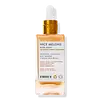What's inside
What's inside
 Key Ingredients
Key Ingredients

 Benefits
Benefits

 Concerns
Concerns

No concerns
 Ingredients Side-by-side
Ingredients Side-by-side

Water
Skin ConditioningPropanediol
SolventCaprylic/Capric Triglyceride
MaskingSimmondsia Chinensis Seed Oil
EmollientButylene Glycol
HumectantXanthan Gum
EmulsifyingPhenoxyethanol
PreservativeBenzyl Benzoate
AntimicrobialAloe Barbadensis Leaf Juice
Skin ConditioningCollagen
MoisturisingAroma
Hexyl Cinnamal
PerfumingTocopherol
AntioxidantHydroxyisohexyl 3-Cyclohexene Carboxaldehyde
MaskingLinalool
PerfumingBenzyl Salicylate
PerfumingAmyl Cinnamal
PerfumingButylphenyl Methylpropional
PerfumingBenzyl Alcohol
PerfumingAscorbic Acid
AntioxidantBHA
AntioxidantEugenol
PerfumingWater, Propanediol, Caprylic/Capric Triglyceride, Simmondsia Chinensis Seed Oil, Butylene Glycol, Xanthan Gum, Phenoxyethanol, Benzyl Benzoate, Aloe Barbadensis Leaf Juice, Collagen, Aroma, Hexyl Cinnamal, Tocopherol, Hydroxyisohexyl 3-Cyclohexene Carboxaldehyde, Linalool, Benzyl Salicylate, Amyl Cinnamal, Butylphenyl Methylpropional, Benzyl Alcohol, Ascorbic Acid, BHA, Eugenol
Aloe Barbadensis Leaf Juice
Skin ConditioningWater
Skin ConditioningJojoba Oil/Caprylic/Capric Triglyceride Esters
Skin ConditioningSimmondsia Chinensis Seed Oil
EmollientPhenoxyethanol
PreservativeAloe Barbadensis Leaf Juice, Water, Jojoba Oil/Caprylic/Capric Triglyceride Esters, Simmondsia Chinensis Seed Oil, Phenoxyethanol, Tetrasodium Glutamate Diacetate, Tocopherol, Kigelia Africana Fruit Extract, Panax Ginseng Root Extract, Cucumis Melo Fruit Extract, Actinidia Chinensis Fruit Extract, CI 15985
Ingredients Explained
These ingredients are found in both products.
Ingredients higher up in an ingredient list are typically present in a larger amount.
Aloe Barbadensis Leaf Juice comes from leaves of the aloe plant. Aloe Barbadensis Leaf Juice is best known for helping to soothe sunburns. It is also anti-inflammatory, moisturizing, antiseptic, and can help heal wounds.
Aloe is packed with good stuff including Vitamins A, C, and E. These vitamins are antioxidants, which help fight free-radicals and the damage they may cause. Free-radicals are molecules that may damage your skin cells, such as pollution.
Aloe Barbadensis Leaf Juice also contains sugars. These sugars come in the form of monosaccharides and polysaccharides, folic acid, and choline. These sugars are able to help bind moisture to skin.
It also contains minerals such as calcium, 12 anthraquinones, fatty acids, amino acids, and Vitamin B12.
Learn more about Aloe Barbadensis Leaf JuicePhenoxyethanol is a preservative that has germicide, antimicrobial, and aromatic properties. Studies show that phenoxyethanol can prevent microbial growth. By itself, it has a scent that is similar to that of a rose.
It's often used in formulations along with Caprylyl Glycol to preserve the shelf life of products.
This oil comes from the seeds of the desert shrub called Jojoba. It is more commonly known as jojoba oil, a non-comedogenic oil.
Jojoba oil does not contain fragrance and has many fatty-acids, making it a great soothing ingredient.
It also contains Vitamin E, a great moisturizing ingredient. Vitamin E is also an antioxidant and protects your skin against oxidative damage.
This ingredient humectant properties, meaning it helps draw moisture from the air. This helps keep your skin hydrated.
While jojoba has antibacterial properties, it is only able to kill some strains of bacteria.
Studies also show it helps in wound healing. In fact, Indigenous cultures have used jojoba as a moisturizer and to help treat burns for centuries.
Fun fact: Jojoba oil similar to natural human skin sebum, so it has a great effect on dry skin. It is also promising with helping to regulate sebum production.
Due to its fatty acid content, Jojoba oil may not be fungal acne safe. We recommend speaking with a professional if you have any concerns.
Learn more about Simmondsia Chinensis Seed OilTocopherol (also known as Vitamin E) is a common antioxidant used to help protect the skin from free-radicals and strengthen the skin barrier. It's also fat soluble - this means our skin is great at absorbing it.
Vitamin E also helps keep your natural skin lipids healthy. Your lipid skin barrier naturally consists of lipids, ceramides, and fatty acids. Vitamin E offers extra protection for your skin’s lipid barrier, keeping your skin healthy and nourished.
Another benefit is a bit of UV protection. Vitamin E helps reduce the damage caused by UVB rays. (It should not replace your sunscreen). Combining it with Vitamin C can decrease sunburned cells and hyperpigmentation after UV exposure.
You might have noticed Vitamin E + C often paired together. This is because it is great at stabilizing Vitamin C. Using the two together helps increase the effectiveness of both ingredients.
There are often claims that Vitamin E can reduce/prevent scarring, but these claims haven't been confirmed by scientific research.
Learn more about TocopherolWater. It's the most common cosmetic ingredient of all. You'll usually see it at the top of ingredient lists, meaning that it makes up the largest part of the product.
So why is it so popular? Water most often acts as a solvent - this means that it helps dissolve other ingredients into the formulation.
You'll also recognize water as that liquid we all need to stay alive. If you see this, drink a glass of water. Stay hydrated!
Learn more about Water